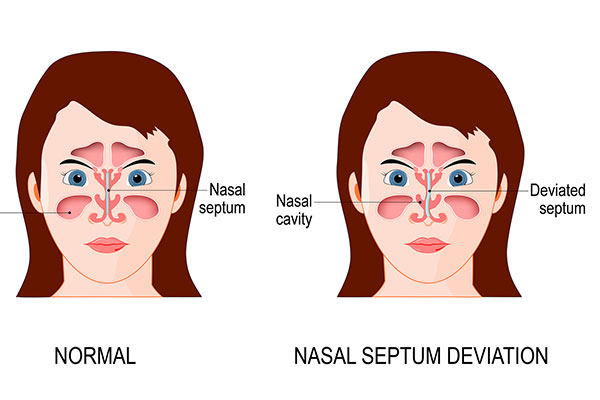Deviated Septum in Children
The nasal septum is made of cartilage and divides the nose into two separate chambers. A deviated septum is an abnormal configuration of the cartilage that divides the two sides of the nasal cavity, which may cause problems with proper breathing or nasal discharge. A deviated septum may be present at birth, caused by an injury, or result from damage from previous medical treatments. Estimates are that 80 percent of all nasal septums are off-center. A deviated septum is when the septum is severely shifted away from the midline.
The most common symptom of a deviated septum is difficulty breathing through the nose. The symptoms are usually worse on one side, and in some cases, the drainage of the sinuses is curtailed and results in repeated sinus infections.
What is septoplasty?
Septoplasty is a reconstructive plastic surgery performed to correct an improperly formed nasal septum. The procedure is performed entirely through the nostrils. During the procedure, badly deviated portions of the septum may be removed entirely, or they may be readjusted and reinserted into the nose.
In addition to correcting a deviated nasal septum, septoplasty may also be performed to correct other problems such as cleft lip/palate defects that affect the nose and nasal cavity and a fistula in the maxillary sinuses.
Oftentimes, septoplasty is not completed until the teenage years due to growing facial bones.
About the procedure
Septoplasty may be performed with the traditional open surgical technique from inside the nose. When open surgery is performed, small scars will be located on the base of the nose, but they usually are not noticeable. Scarring is not visible when internal surgery is performed.
The surgeon will provide guidelines for resuming normal activities. Many children are up and around within a few days and able to return to school in a week or so.
What are the complications associated with nasal surgery?
Children vary greatly in their anatomy and healing ability, and the outcome is never completely predictable. Complications may occur, including, but not limited to, infection, nosebleeds, or reaction to the anesthesia.
What are the short-term side effects of nasal surgery?
The following short-term side effects may occur. If symptoms do not subside, consult your child’s physician.
- The face will feel puffy
- Nose may ache
- Dull headache
- Swelling around the eyes
- Bruising around the eyes
- A small amount of bleeding in the first few days
- Small burst blood vessels may appear as tiny red spots on the skin’s surface
Healing is a slow and gradual process. Some swelling may be present for months, especially on the tip of the nose. The final results of nasal surgery may not be apparent for a year or more.
Expert Care from a pediatric ENT specialist in Atlanta for Your Child’s ENT Needs
If your child is struggling with breathing issues, sinus infections, or other symptoms related to a deviated septum, a pediatric ENT specialist in Atlanta can provide expert and compassionate treatment. Our skilled team offers advanced care, including septoplasty, to ensure your child’s comfort and health.
We are proud to extend our specialized services to families in Alpharetta, Duluth, and Marietta, bringing high-quality pediatric ENT care closer to home. Contact us today to schedule an appointment and take the first step toward improving your child’s well-being.


